BU4001: Analysis of Organizational Culture, Group Dynamics and Stress
VerifiedAdded on 2023/06/12
|12
|2451
|406
Report
AI Summary
This report provides an overview of key concepts in organizational management. It begins by defining organizational culture and explaining its components, including shared behaviors, beliefs, work practices, and values. It then delves into Tuckman's theory of group development, outlining the forming, storming, norming, performing, and adjourning stages, and discusses the importance of group cohesiveness. The report also examines organizational communication, distinguishing between internal, external, and personal communication. Furthermore, it explores the impact of technology on businesses, highlighting both its positive effects, such as increased production and innovation, and its negative effects, such as increased security risks and job displacement. Finally, the report addresses the issue of workplace stress, identifying its causes and effects, and suggesting strategies for stress management. Desklib offers more resources like this to aid students in their studies.
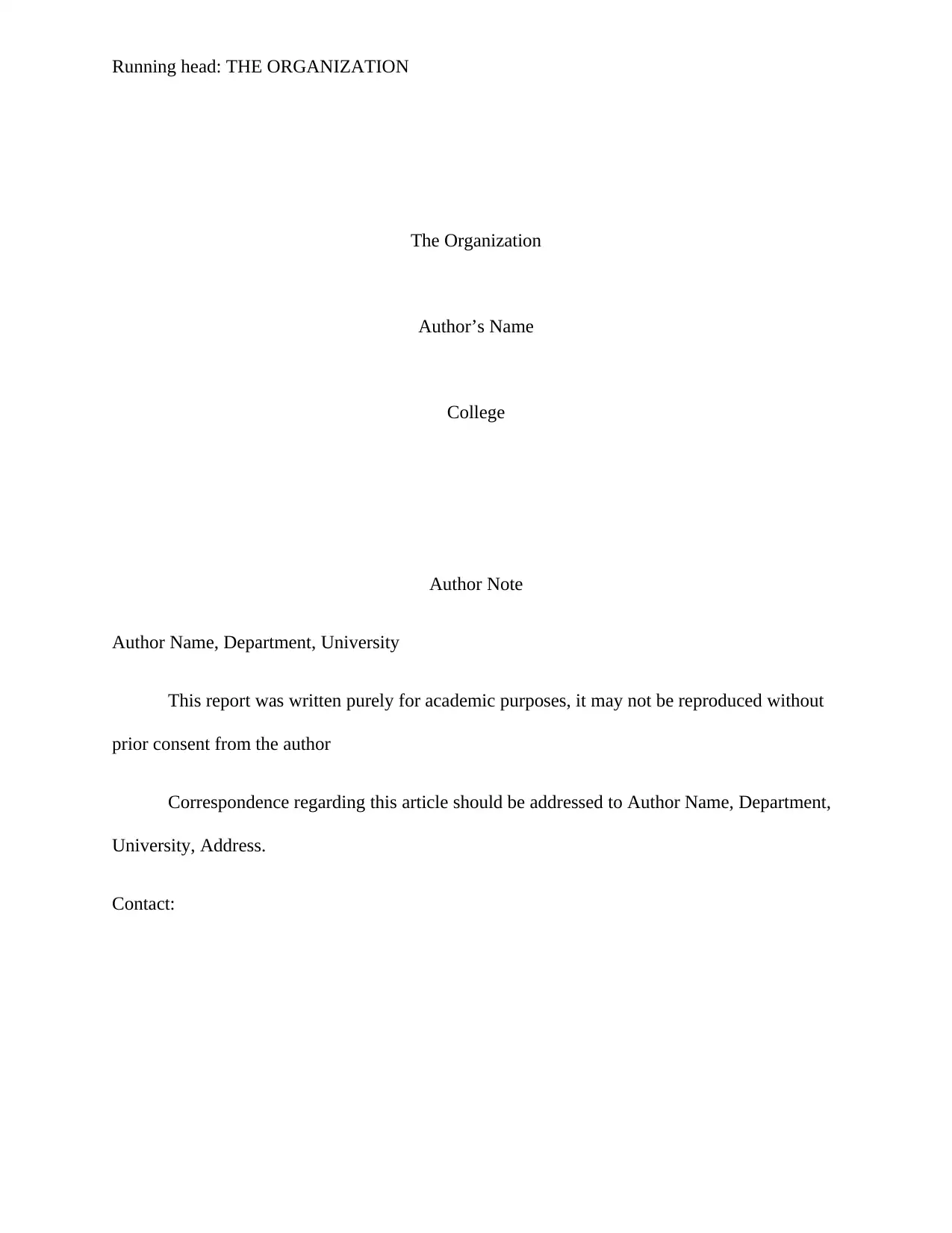
Running head: THE ORGANIZATION
The Organization
Author’s Name
College
Author Note
Author Name, Department, University
This report was written purely for academic purposes, it may not be reproduced without
prior consent from the author
Correspondence regarding this article should be addressed to Author Name, Department,
University, Address.
Contact:
The Organization
Author’s Name
College
Author Note
Author Name, Department, University
This report was written purely for academic purposes, it may not be reproduced without
prior consent from the author
Correspondence regarding this article should be addressed to Author Name, Department,
University, Address.
Contact:
Paraphrase This Document
Need a fresh take? Get an instant paraphrase of this document with our AI Paraphraser
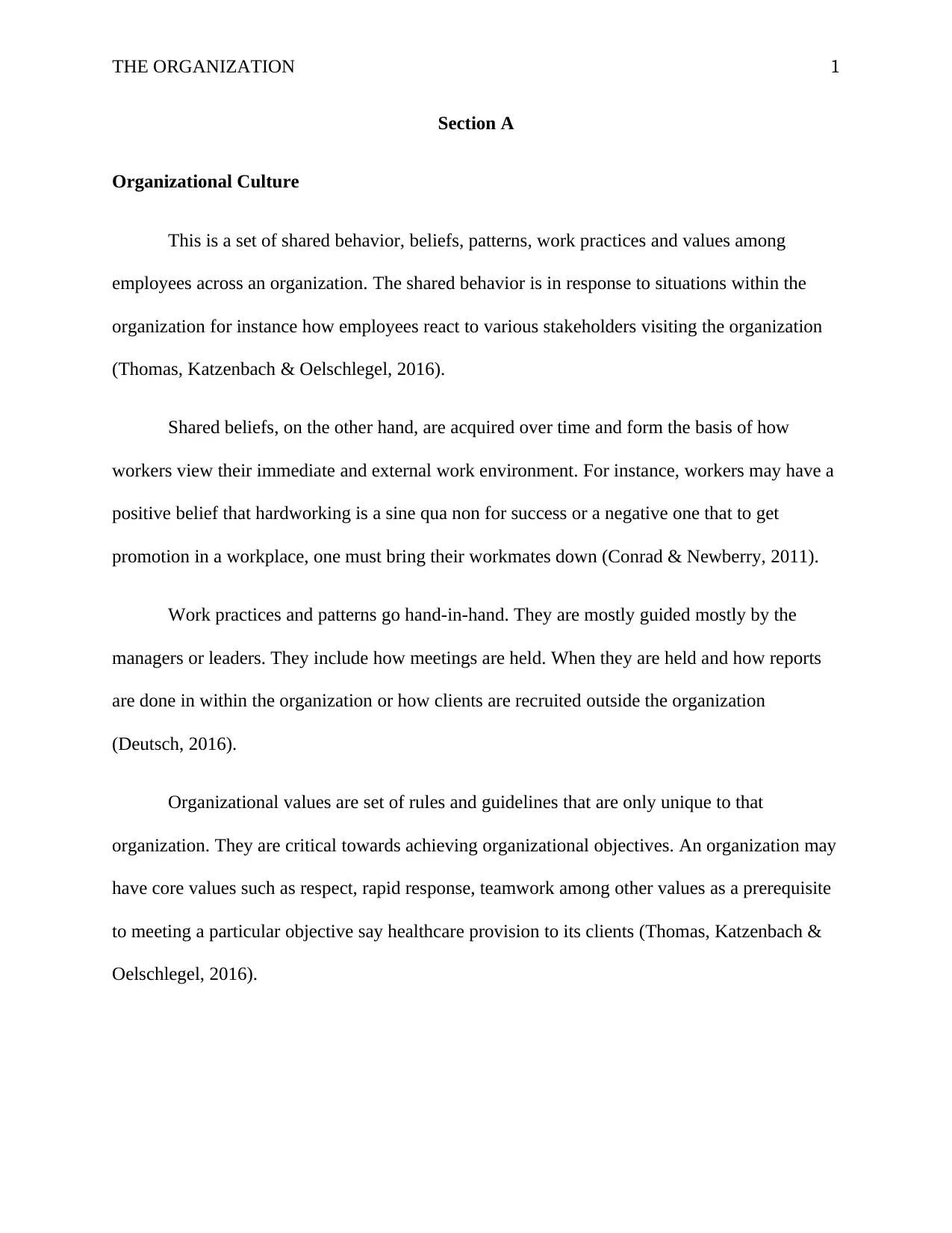
THE ORGANIZATION 1
Section A
Organizational Culture
This is a set of shared behavior, beliefs, patterns, work practices and values among
employees across an organization. The shared behavior is in response to situations within the
organization for instance how employees react to various stakeholders visiting the organization
(Thomas, Katzenbach & Oelschlegel, 2016).
Shared beliefs, on the other hand, are acquired over time and form the basis of how
workers view their immediate and external work environment. For instance, workers may have a
positive belief that hardworking is a sine qua non for success or a negative one that to get
promotion in a workplace, one must bring their workmates down (Conrad & Newberry, 2011).
Work practices and patterns go hand-in-hand. They are mostly guided mostly by the
managers or leaders. They include how meetings are held. When they are held and how reports
are done in within the organization or how clients are recruited outside the organization
(Deutsch, 2016).
Organizational values are set of rules and guidelines that are only unique to that
organization. They are critical towards achieving organizational objectives. An organization may
have core values such as respect, rapid response, teamwork among other values as a prerequisite
to meeting a particular objective say healthcare provision to its clients (Thomas, Katzenbach &
Oelschlegel, 2016).
Section A
Organizational Culture
This is a set of shared behavior, beliefs, patterns, work practices and values among
employees across an organization. The shared behavior is in response to situations within the
organization for instance how employees react to various stakeholders visiting the organization
(Thomas, Katzenbach & Oelschlegel, 2016).
Shared beliefs, on the other hand, are acquired over time and form the basis of how
workers view their immediate and external work environment. For instance, workers may have a
positive belief that hardworking is a sine qua non for success or a negative one that to get
promotion in a workplace, one must bring their workmates down (Conrad & Newberry, 2011).
Work practices and patterns go hand-in-hand. They are mostly guided mostly by the
managers or leaders. They include how meetings are held. When they are held and how reports
are done in within the organization or how clients are recruited outside the organization
(Deutsch, 2016).
Organizational values are set of rules and guidelines that are only unique to that
organization. They are critical towards achieving organizational objectives. An organization may
have core values such as respect, rapid response, teamwork among other values as a prerequisite
to meeting a particular objective say healthcare provision to its clients (Thomas, Katzenbach &
Oelschlegel, 2016).
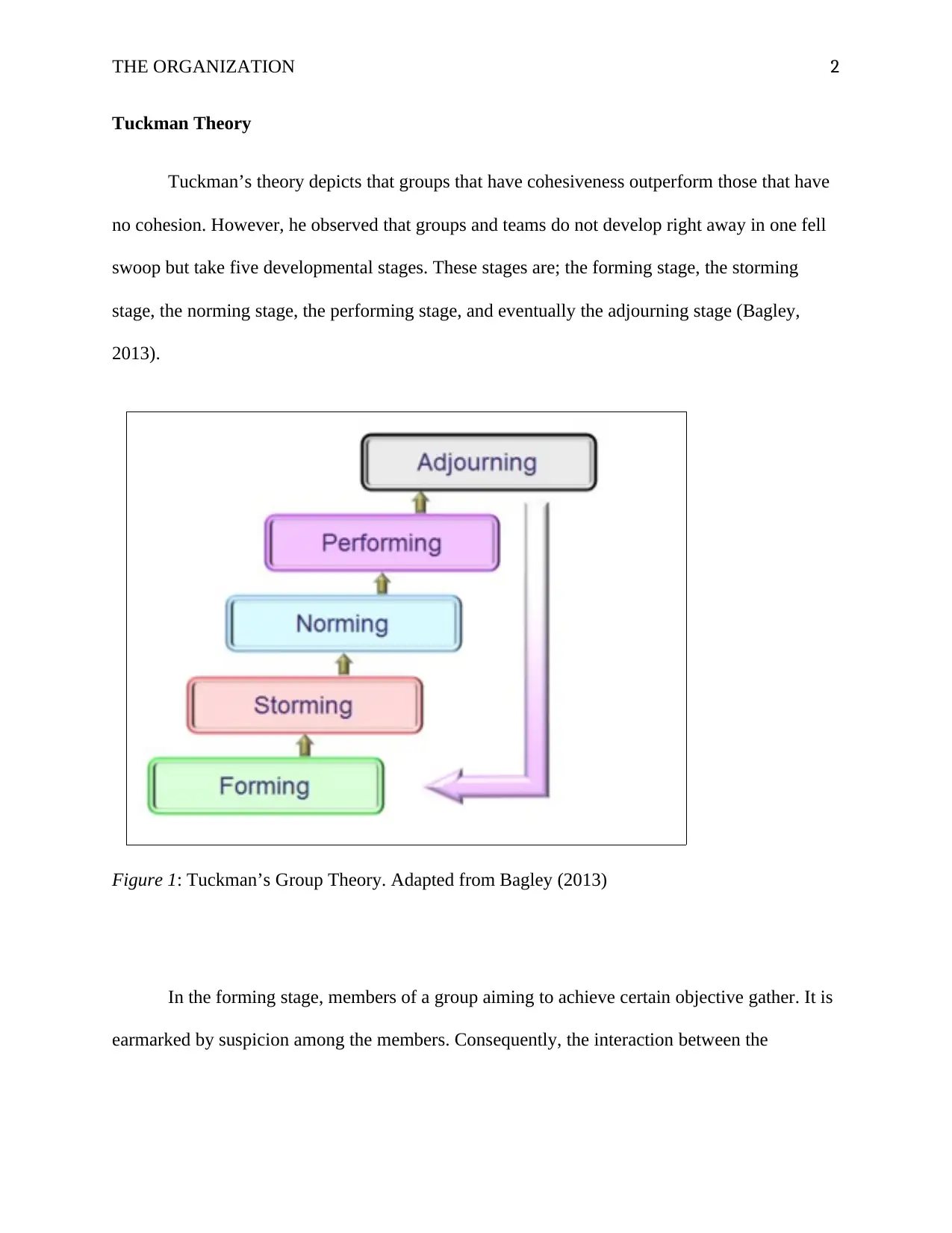
THE ORGANIZATION 2
Tuckman Theory
Tuckman’s theory depicts that groups that have cohesiveness outperform those that have
no cohesion. However, he observed that groups and teams do not develop right away in one fell
swoop but take five developmental stages. These stages are; the forming stage, the storming
stage, the norming stage, the performing stage, and eventually the adjourning stage (Bagley,
2013).
Figure 1: Tuckman’s Group Theory. Adapted from Bagley (2013)
In the forming stage, members of a group aiming to achieve certain objective gather. It is
earmarked by suspicion among the members. Consequently, the interaction between the
Tuckman Theory
Tuckman’s theory depicts that groups that have cohesiveness outperform those that have
no cohesion. However, he observed that groups and teams do not develop right away in one fell
swoop but take five developmental stages. These stages are; the forming stage, the storming
stage, the norming stage, the performing stage, and eventually the adjourning stage (Bagley,
2013).
Figure 1: Tuckman’s Group Theory. Adapted from Bagley (2013)
In the forming stage, members of a group aiming to achieve certain objective gather. It is
earmarked by suspicion among the members. Consequently, the interaction between the
⊘ This is a preview!⊘
Do you want full access?
Subscribe today to unlock all pages.

Trusted by 1+ million students worldwide
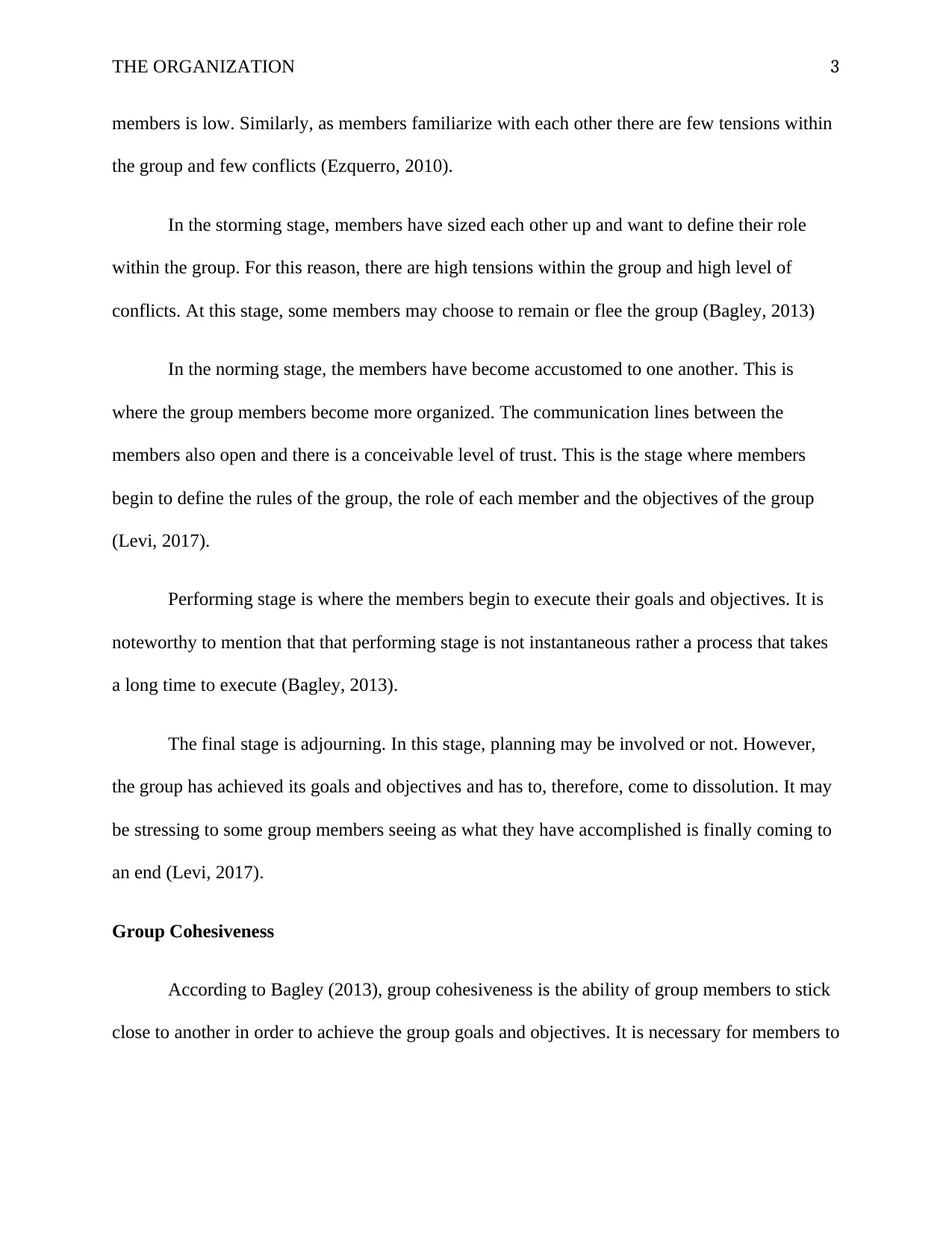
THE ORGANIZATION 3
members is low. Similarly, as members familiarize with each other there are few tensions within
the group and few conflicts (Ezquerro, 2010).
In the storming stage, members have sized each other up and want to define their role
within the group. For this reason, there are high tensions within the group and high level of
conflicts. At this stage, some members may choose to remain or flee the group (Bagley, 2013)
In the norming stage, the members have become accustomed to one another. This is
where the group members become more organized. The communication lines between the
members also open and there is a conceivable level of trust. This is the stage where members
begin to define the rules of the group, the role of each member and the objectives of the group
(Levi, 2017).
Performing stage is where the members begin to execute their goals and objectives. It is
noteworthy to mention that that performing stage is not instantaneous rather a process that takes
a long time to execute (Bagley, 2013).
The final stage is adjourning. In this stage, planning may be involved or not. However,
the group has achieved its goals and objectives and has to, therefore, come to dissolution. It may
be stressing to some group members seeing as what they have accomplished is finally coming to
an end (Levi, 2017).
Group Cohesiveness
According to Bagley (2013), group cohesiveness is the ability of group members to stick
close to another in order to achieve the group goals and objectives. It is necessary for members to
members is low. Similarly, as members familiarize with each other there are few tensions within
the group and few conflicts (Ezquerro, 2010).
In the storming stage, members have sized each other up and want to define their role
within the group. For this reason, there are high tensions within the group and high level of
conflicts. At this stage, some members may choose to remain or flee the group (Bagley, 2013)
In the norming stage, the members have become accustomed to one another. This is
where the group members become more organized. The communication lines between the
members also open and there is a conceivable level of trust. This is the stage where members
begin to define the rules of the group, the role of each member and the objectives of the group
(Levi, 2017).
Performing stage is where the members begin to execute their goals and objectives. It is
noteworthy to mention that that performing stage is not instantaneous rather a process that takes
a long time to execute (Bagley, 2013).
The final stage is adjourning. In this stage, planning may be involved or not. However,
the group has achieved its goals and objectives and has to, therefore, come to dissolution. It may
be stressing to some group members seeing as what they have accomplished is finally coming to
an end (Levi, 2017).
Group Cohesiveness
According to Bagley (2013), group cohesiveness is the ability of group members to stick
close to another in order to achieve the group goals and objectives. It is necessary for members to
Paraphrase This Document
Need a fresh take? Get an instant paraphrase of this document with our AI Paraphraser
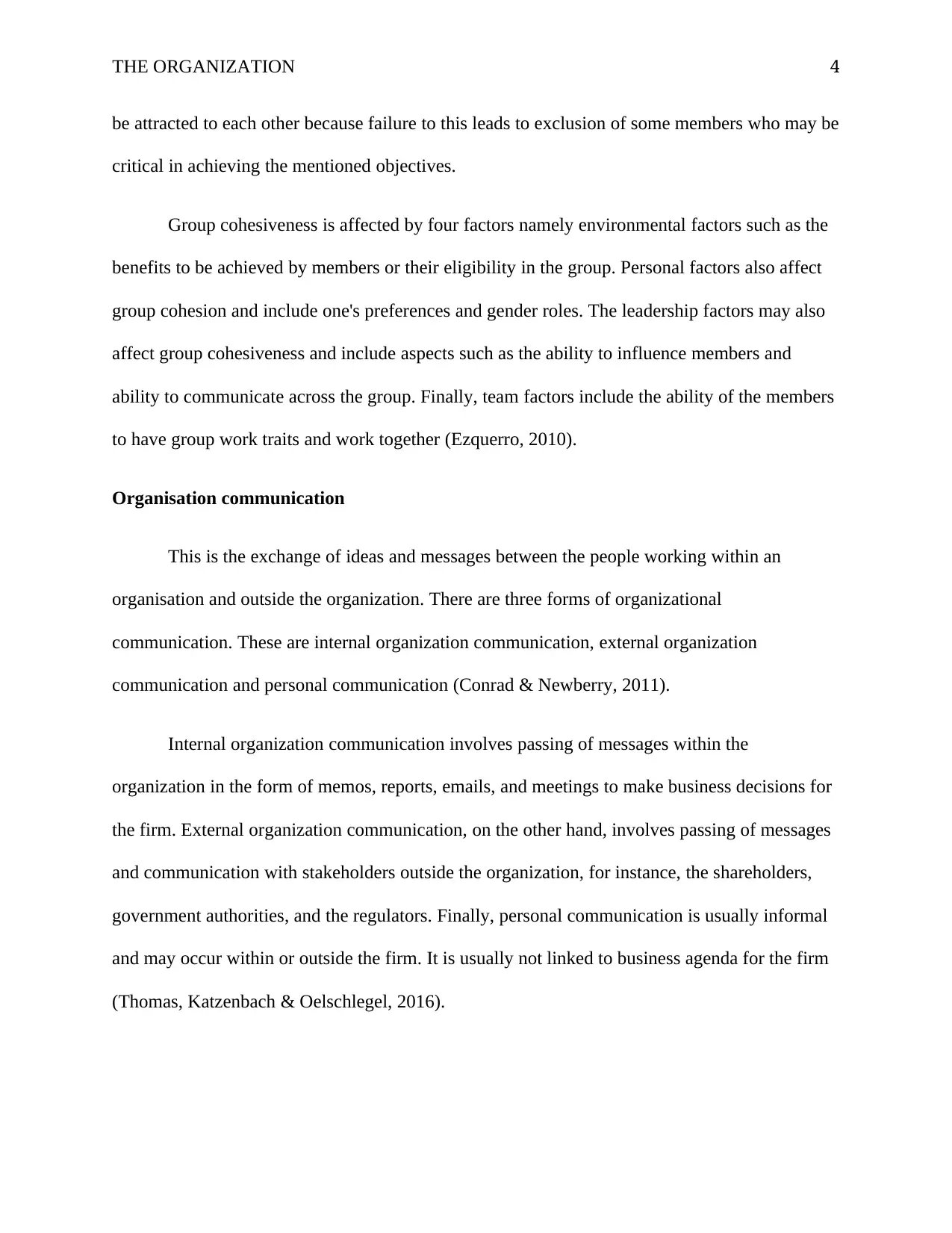
THE ORGANIZATION 4
be attracted to each other because failure to this leads to exclusion of some members who may be
critical in achieving the mentioned objectives.
Group cohesiveness is affected by four factors namely environmental factors such as the
benefits to be achieved by members or their eligibility in the group. Personal factors also affect
group cohesion and include one's preferences and gender roles. The leadership factors may also
affect group cohesiveness and include aspects such as the ability to influence members and
ability to communicate across the group. Finally, team factors include the ability of the members
to have group work traits and work together (Ezquerro, 2010).
Organisation communication
This is the exchange of ideas and messages between the people working within an
organisation and outside the organization. There are three forms of organizational
communication. These are internal organization communication, external organization
communication and personal communication (Conrad & Newberry, 2011).
Internal organization communication involves passing of messages within the
organization in the form of memos, reports, emails, and meetings to make business decisions for
the firm. External organization communication, on the other hand, involves passing of messages
and communication with stakeholders outside the organization, for instance, the shareholders,
government authorities, and the regulators. Finally, personal communication is usually informal
and may occur within or outside the firm. It is usually not linked to business agenda for the firm
(Thomas, Katzenbach & Oelschlegel, 2016).
be attracted to each other because failure to this leads to exclusion of some members who may be
critical in achieving the mentioned objectives.
Group cohesiveness is affected by four factors namely environmental factors such as the
benefits to be achieved by members or their eligibility in the group. Personal factors also affect
group cohesion and include one's preferences and gender roles. The leadership factors may also
affect group cohesiveness and include aspects such as the ability to influence members and
ability to communicate across the group. Finally, team factors include the ability of the members
to have group work traits and work together (Ezquerro, 2010).
Organisation communication
This is the exchange of ideas and messages between the people working within an
organisation and outside the organization. There are three forms of organizational
communication. These are internal organization communication, external organization
communication and personal communication (Conrad & Newberry, 2011).
Internal organization communication involves passing of messages within the
organization in the form of memos, reports, emails, and meetings to make business decisions for
the firm. External organization communication, on the other hand, involves passing of messages
and communication with stakeholders outside the organization, for instance, the shareholders,
government authorities, and the regulators. Finally, personal communication is usually informal
and may occur within or outside the firm. It is usually not linked to business agenda for the firm
(Thomas, Katzenbach & Oelschlegel, 2016).
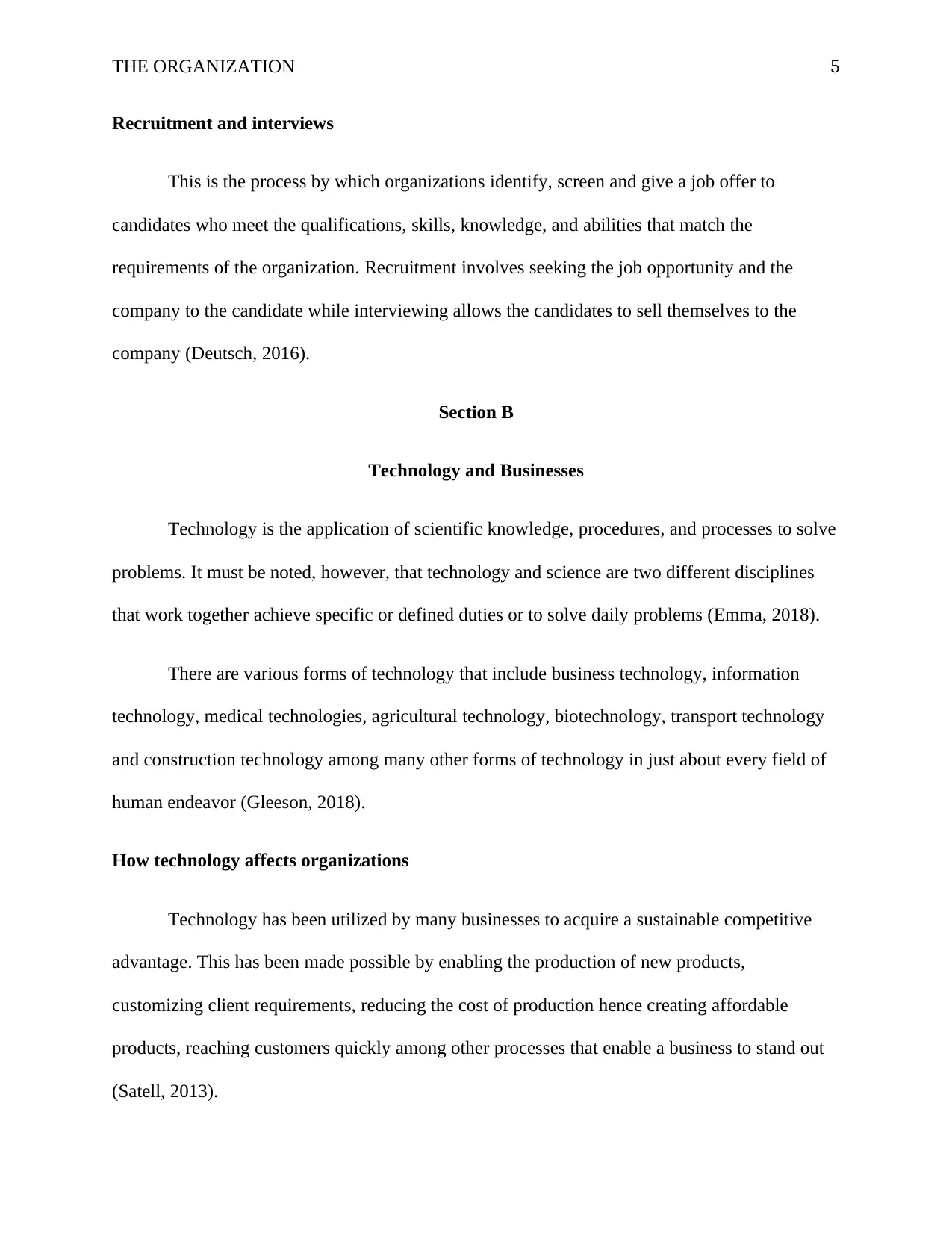
THE ORGANIZATION 5
Recruitment and interviews
This is the process by which organizations identify, screen and give a job offer to
candidates who meet the qualifications, skills, knowledge, and abilities that match the
requirements of the organization. Recruitment involves seeking the job opportunity and the
company to the candidate while interviewing allows the candidates to sell themselves to the
company (Deutsch, 2016).
Section B
Technology and Businesses
Technology is the application of scientific knowledge, procedures, and processes to solve
problems. It must be noted, however, that technology and science are two different disciplines
that work together achieve specific or defined duties or to solve daily problems (Emma, 2018).
There are various forms of technology that include business technology, information
technology, medical technologies, agricultural technology, biotechnology, transport technology
and construction technology among many other forms of technology in just about every field of
human endeavor (Gleeson, 2018).
How technology affects organizations
Technology has been utilized by many businesses to acquire a sustainable competitive
advantage. This has been made possible by enabling the production of new products,
customizing client requirements, reducing the cost of production hence creating affordable
products, reaching customers quickly among other processes that enable a business to stand out
(Satell, 2013).
Recruitment and interviews
This is the process by which organizations identify, screen and give a job offer to
candidates who meet the qualifications, skills, knowledge, and abilities that match the
requirements of the organization. Recruitment involves seeking the job opportunity and the
company to the candidate while interviewing allows the candidates to sell themselves to the
company (Deutsch, 2016).
Section B
Technology and Businesses
Technology is the application of scientific knowledge, procedures, and processes to solve
problems. It must be noted, however, that technology and science are two different disciplines
that work together achieve specific or defined duties or to solve daily problems (Emma, 2018).
There are various forms of technology that include business technology, information
technology, medical technologies, agricultural technology, biotechnology, transport technology
and construction technology among many other forms of technology in just about every field of
human endeavor (Gleeson, 2018).
How technology affects organizations
Technology has been utilized by many businesses to acquire a sustainable competitive
advantage. This has been made possible by enabling the production of new products,
customizing client requirements, reducing the cost of production hence creating affordable
products, reaching customers quickly among other processes that enable a business to stand out
(Satell, 2013).
⊘ This is a preview!⊘
Do you want full access?
Subscribe today to unlock all pages.

Trusted by 1+ million students worldwide
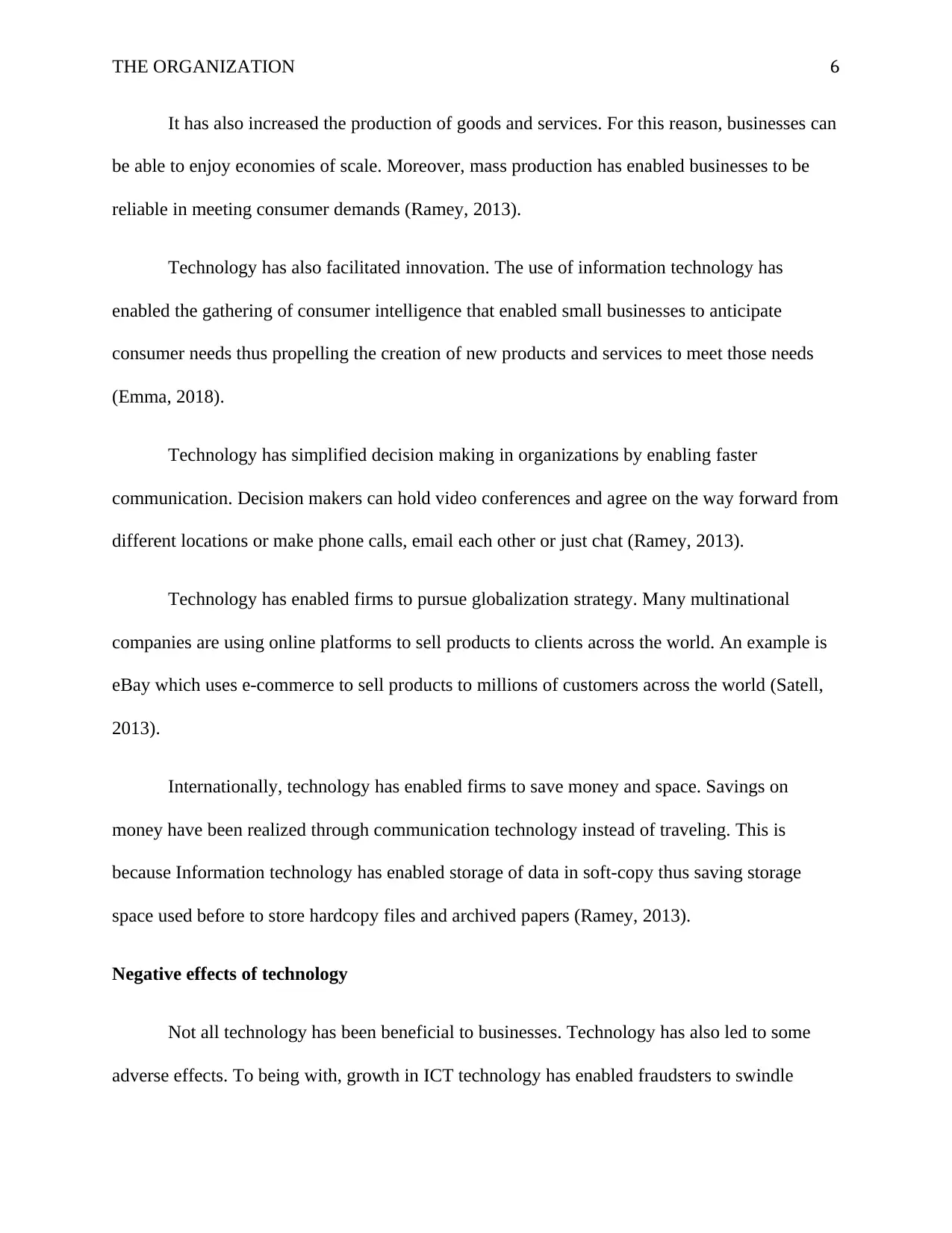
THE ORGANIZATION 6
It has also increased the production of goods and services. For this reason, businesses can
be able to enjoy economies of scale. Moreover, mass production has enabled businesses to be
reliable in meeting consumer demands (Ramey, 2013).
Technology has also facilitated innovation. The use of information technology has
enabled the gathering of consumer intelligence that enabled small businesses to anticipate
consumer needs thus propelling the creation of new products and services to meet those needs
(Emma, 2018).
Technology has simplified decision making in organizations by enabling faster
communication. Decision makers can hold video conferences and agree on the way forward from
different locations or make phone calls, email each other or just chat (Ramey, 2013).
Technology has enabled firms to pursue globalization strategy. Many multinational
companies are using online platforms to sell products to clients across the world. An example is
eBay which uses e-commerce to sell products to millions of customers across the world (Satell,
2013).
Internationally, technology has enabled firms to save money and space. Savings on
money have been realized through communication technology instead of traveling. This is
because Information technology has enabled storage of data in soft-copy thus saving storage
space used before to store hardcopy files and archived papers (Ramey, 2013).
Negative effects of technology
Not all technology has been beneficial to businesses. Technology has also led to some
adverse effects. To being with, growth in ICT technology has enabled fraudsters to swindle
It has also increased the production of goods and services. For this reason, businesses can
be able to enjoy economies of scale. Moreover, mass production has enabled businesses to be
reliable in meeting consumer demands (Ramey, 2013).
Technology has also facilitated innovation. The use of information technology has
enabled the gathering of consumer intelligence that enabled small businesses to anticipate
consumer needs thus propelling the creation of new products and services to meet those needs
(Emma, 2018).
Technology has simplified decision making in organizations by enabling faster
communication. Decision makers can hold video conferences and agree on the way forward from
different locations or make phone calls, email each other or just chat (Ramey, 2013).
Technology has enabled firms to pursue globalization strategy. Many multinational
companies are using online platforms to sell products to clients across the world. An example is
eBay which uses e-commerce to sell products to millions of customers across the world (Satell,
2013).
Internationally, technology has enabled firms to save money and space. Savings on
money have been realized through communication technology instead of traveling. This is
because Information technology has enabled storage of data in soft-copy thus saving storage
space used before to store hardcopy files and archived papers (Ramey, 2013).
Negative effects of technology
Not all technology has been beneficial to businesses. Technology has also led to some
adverse effects. To being with, growth in ICT technology has enabled fraudsters to swindle
Paraphrase This Document
Need a fresh take? Get an instant paraphrase of this document with our AI Paraphraser
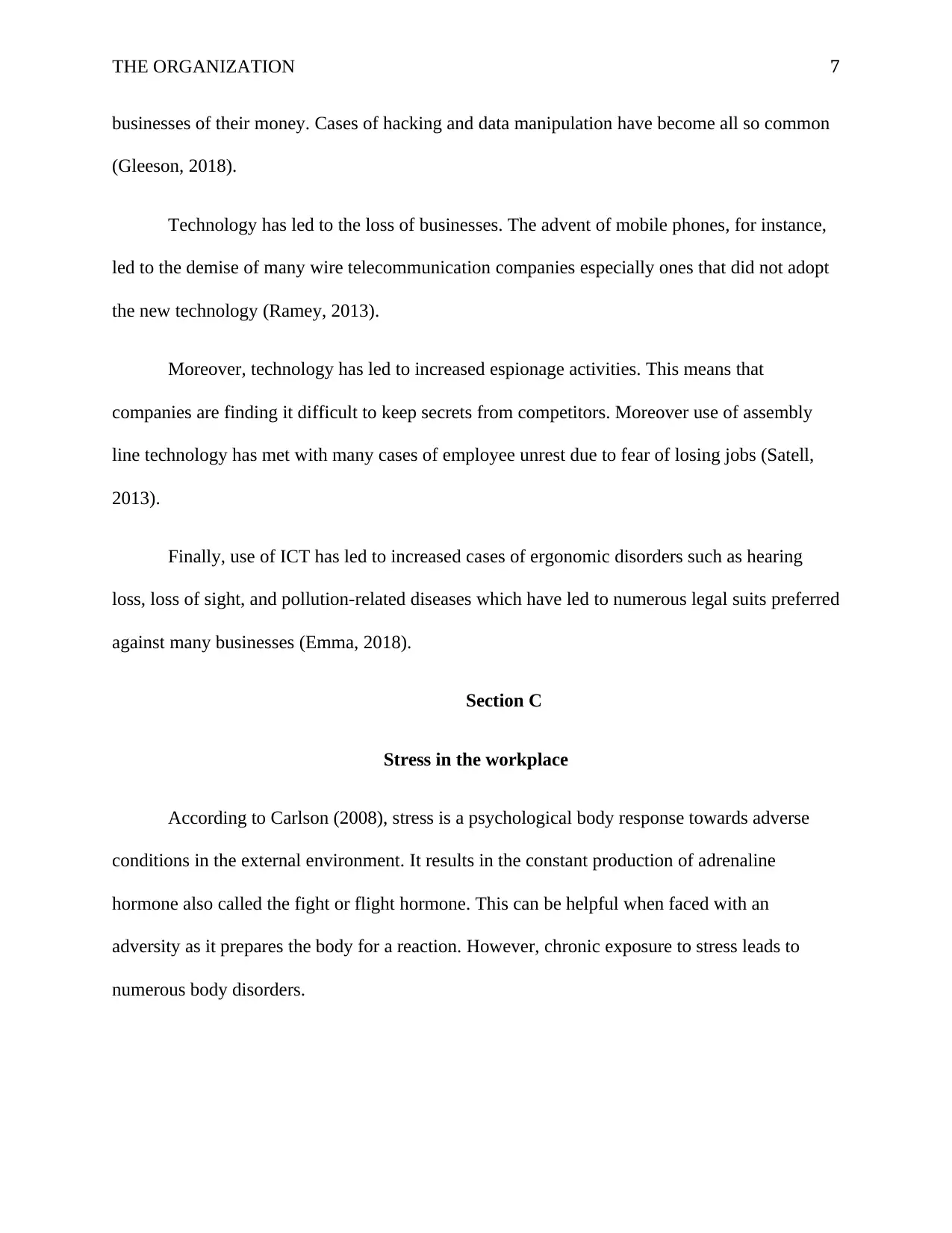
THE ORGANIZATION 7
businesses of their money. Cases of hacking and data manipulation have become all so common
(Gleeson, 2018).
Technology has led to the loss of businesses. The advent of mobile phones, for instance,
led to the demise of many wire telecommunication companies especially ones that did not adopt
the new technology (Ramey, 2013).
Moreover, technology has led to increased espionage activities. This means that
companies are finding it difficult to keep secrets from competitors. Moreover use of assembly
line technology has met with many cases of employee unrest due to fear of losing jobs (Satell,
2013).
Finally, use of ICT has led to increased cases of ergonomic disorders such as hearing
loss, loss of sight, and pollution-related diseases which have led to numerous legal suits preferred
against many businesses (Emma, 2018).
Section C
Stress in the workplace
According to Carlson (2008), stress is a psychological body response towards adverse
conditions in the external environment. It results in the constant production of adrenaline
hormone also called the fight or flight hormone. This can be helpful when faced with an
adversity as it prepares the body for a reaction. However, chronic exposure to stress leads to
numerous body disorders.
businesses of their money. Cases of hacking and data manipulation have become all so common
(Gleeson, 2018).
Technology has led to the loss of businesses. The advent of mobile phones, for instance,
led to the demise of many wire telecommunication companies especially ones that did not adopt
the new technology (Ramey, 2013).
Moreover, technology has led to increased espionage activities. This means that
companies are finding it difficult to keep secrets from competitors. Moreover use of assembly
line technology has met with many cases of employee unrest due to fear of losing jobs (Satell,
2013).
Finally, use of ICT has led to increased cases of ergonomic disorders such as hearing
loss, loss of sight, and pollution-related diseases which have led to numerous legal suits preferred
against many businesses (Emma, 2018).
Section C
Stress in the workplace
According to Carlson (2008), stress is a psychological body response towards adverse
conditions in the external environment. It results in the constant production of adrenaline
hormone also called the fight or flight hormone. This can be helpful when faced with an
adversity as it prepares the body for a reaction. However, chronic exposure to stress leads to
numerous body disorders.
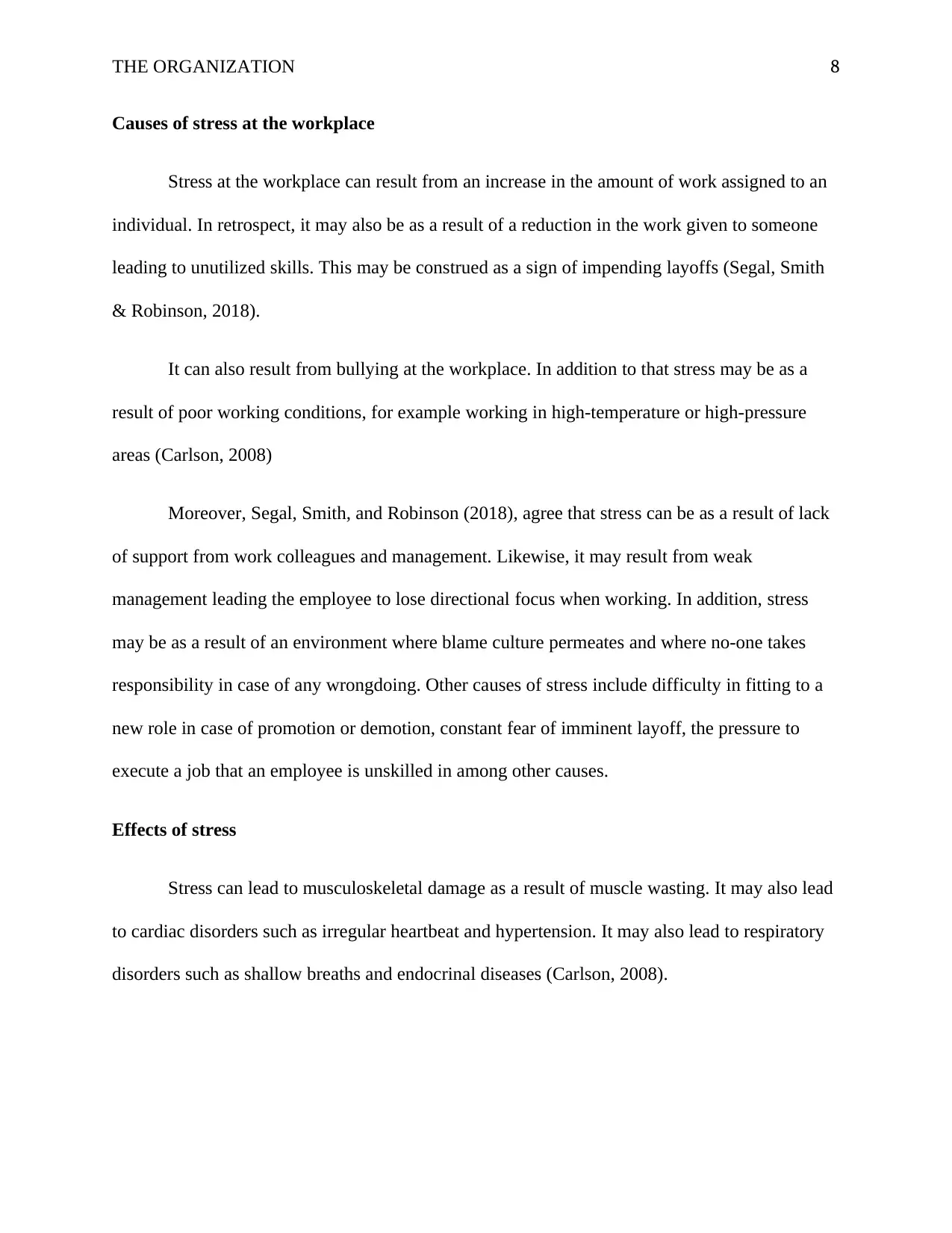
THE ORGANIZATION 8
Causes of stress at the workplace
Stress at the workplace can result from an increase in the amount of work assigned to an
individual. In retrospect, it may also be as a result of a reduction in the work given to someone
leading to unutilized skills. This may be construed as a sign of impending layoffs (Segal, Smith
& Robinson, 2018).
It can also result from bullying at the workplace. In addition to that stress may be as a
result of poor working conditions, for example working in high-temperature or high-pressure
areas (Carlson, 2008)
Moreover, Segal, Smith, and Robinson (2018), agree that stress can be as a result of lack
of support from work colleagues and management. Likewise, it may result from weak
management leading the employee to lose directional focus when working. In addition, stress
may be as a result of an environment where blame culture permeates and where no-one takes
responsibility in case of any wrongdoing. Other causes of stress include difficulty in fitting to a
new role in case of promotion or demotion, constant fear of imminent layoff, the pressure to
execute a job that an employee is unskilled in among other causes.
Effects of stress
Stress can lead to musculoskeletal damage as a result of muscle wasting. It may also lead
to cardiac disorders such as irregular heartbeat and hypertension. It may also lead to respiratory
disorders such as shallow breaths and endocrinal diseases (Carlson, 2008).
Causes of stress at the workplace
Stress at the workplace can result from an increase in the amount of work assigned to an
individual. In retrospect, it may also be as a result of a reduction in the work given to someone
leading to unutilized skills. This may be construed as a sign of impending layoffs (Segal, Smith
& Robinson, 2018).
It can also result from bullying at the workplace. In addition to that stress may be as a
result of poor working conditions, for example working in high-temperature or high-pressure
areas (Carlson, 2008)
Moreover, Segal, Smith, and Robinson (2018), agree that stress can be as a result of lack
of support from work colleagues and management. Likewise, it may result from weak
management leading the employee to lose directional focus when working. In addition, stress
may be as a result of an environment where blame culture permeates and where no-one takes
responsibility in case of any wrongdoing. Other causes of stress include difficulty in fitting to a
new role in case of promotion or demotion, constant fear of imminent layoff, the pressure to
execute a job that an employee is unskilled in among other causes.
Effects of stress
Stress can lead to musculoskeletal damage as a result of muscle wasting. It may also lead
to cardiac disorders such as irregular heartbeat and hypertension. It may also lead to respiratory
disorders such as shallow breaths and endocrinal diseases (Carlson, 2008).
⊘ This is a preview!⊘
Do you want full access?
Subscribe today to unlock all pages.

Trusted by 1+ million students worldwide
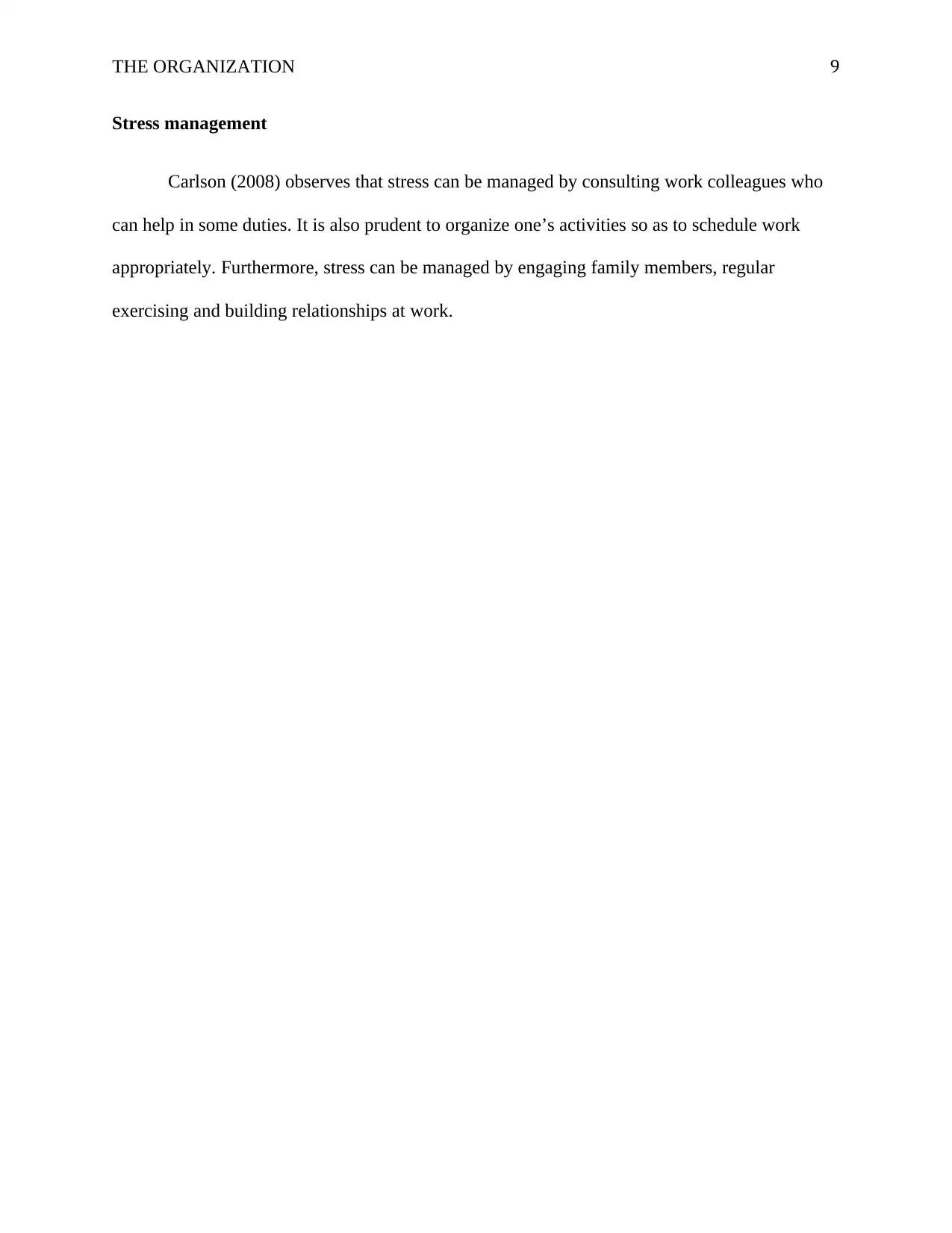
THE ORGANIZATION 9
Stress management
Carlson (2008) observes that stress can be managed by consulting work colleagues who
can help in some duties. It is also prudent to organize one’s activities so as to schedule work
appropriately. Furthermore, stress can be managed by engaging family members, regular
exercising and building relationships at work.
Stress management
Carlson (2008) observes that stress can be managed by consulting work colleagues who
can help in some duties. It is also prudent to organize one’s activities so as to schedule work
appropriately. Furthermore, stress can be managed by engaging family members, regular
exercising and building relationships at work.
Paraphrase This Document
Need a fresh take? Get an instant paraphrase of this document with our AI Paraphraser
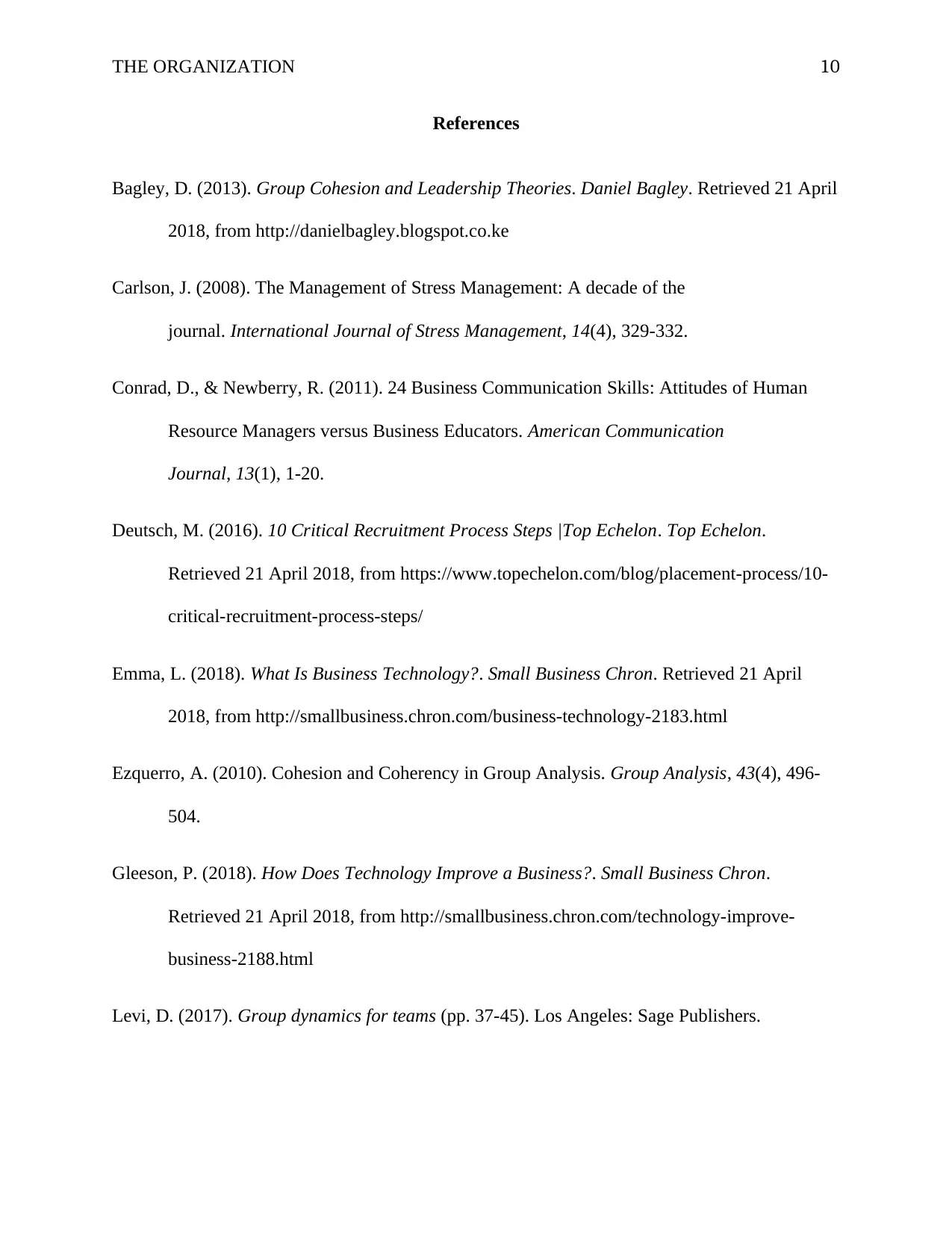
THE ORGANIZATION 10
References
Bagley, D. (2013). Group Cohesion and Leadership Theories. Daniel Bagley. Retrieved 21 April
2018, from http://danielbagley.blogspot.co.ke
Carlson, J. (2008). The Management of Stress Management: A decade of the
journal. International Journal of Stress Management, 14(4), 329-332.
Conrad, D., & Newberry, R. (2011). 24 Business Communication Skills: Attitudes of Human
Resource Managers versus Business Educators. American Communication
Journal, 13(1), 1-20.
Deutsch, M. (2016). 10 Critical Recruitment Process Steps |Top Echelon. Top Echelon.
Retrieved 21 April 2018, from https://www.topechelon.com/blog/placement-process/10-
critical-recruitment-process-steps/
Emma, L. (2018). What Is Business Technology?. Small Business Chron. Retrieved 21 April
2018, from http://smallbusiness.chron.com/business-technology-2183.html
Ezquerro, A. (2010). Cohesion and Coherency in Group Analysis. Group Analysis, 43(4), 496-
504.
Gleeson, P. (2018). How Does Technology Improve a Business?. Small Business Chron.
Retrieved 21 April 2018, from http://smallbusiness.chron.com/technology-improve-
business-2188.html
Levi, D. (2017). Group dynamics for teams (pp. 37-45). Los Angeles: Sage Publishers.
References
Bagley, D. (2013). Group Cohesion and Leadership Theories. Daniel Bagley. Retrieved 21 April
2018, from http://danielbagley.blogspot.co.ke
Carlson, J. (2008). The Management of Stress Management: A decade of the
journal. International Journal of Stress Management, 14(4), 329-332.
Conrad, D., & Newberry, R. (2011). 24 Business Communication Skills: Attitudes of Human
Resource Managers versus Business Educators. American Communication
Journal, 13(1), 1-20.
Deutsch, M. (2016). 10 Critical Recruitment Process Steps |Top Echelon. Top Echelon.
Retrieved 21 April 2018, from https://www.topechelon.com/blog/placement-process/10-
critical-recruitment-process-steps/
Emma, L. (2018). What Is Business Technology?. Small Business Chron. Retrieved 21 April
2018, from http://smallbusiness.chron.com/business-technology-2183.html
Ezquerro, A. (2010). Cohesion and Coherency in Group Analysis. Group Analysis, 43(4), 496-
504.
Gleeson, P. (2018). How Does Technology Improve a Business?. Small Business Chron.
Retrieved 21 April 2018, from http://smallbusiness.chron.com/technology-improve-
business-2188.html
Levi, D. (2017). Group dynamics for teams (pp. 37-45). Los Angeles: Sage Publishers.
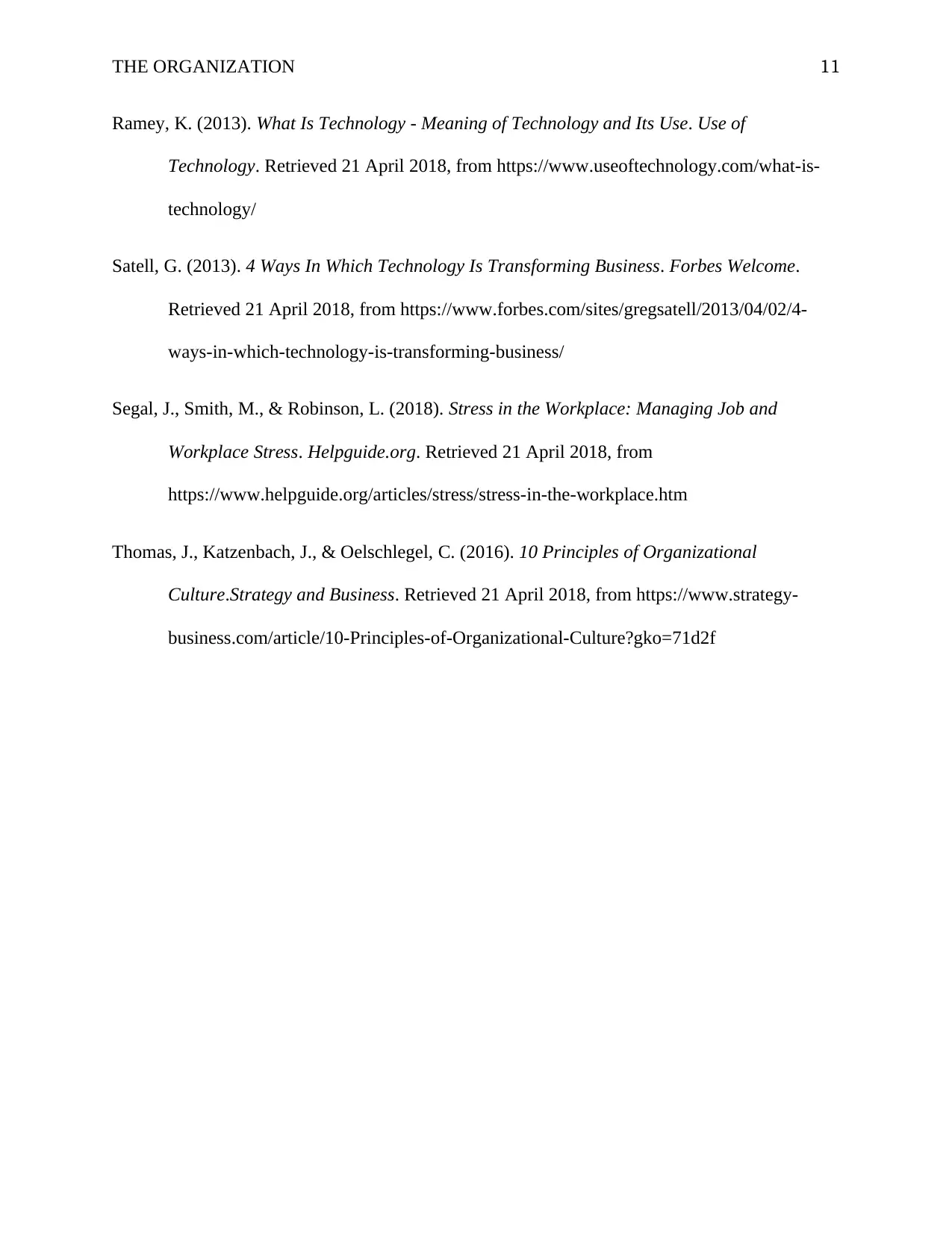
THE ORGANIZATION 11
Ramey, K. (2013). What Is Technology - Meaning of Technology and Its Use. Use of
Technology. Retrieved 21 April 2018, from https://www.useoftechnology.com/what-is-
technology/
Satell, G. (2013). 4 Ways In Which Technology Is Transforming Business. Forbes Welcome.
Retrieved 21 April 2018, from https://www.forbes.com/sites/gregsatell/2013/04/02/4-
ways-in-which-technology-is-transforming-business/
Segal, J., Smith, M., & Robinson, L. (2018). Stress in the Workplace: Managing Job and
Workplace Stress. Helpguide.org. Retrieved 21 April 2018, from
https://www.helpguide.org/articles/stress/stress-in-the-workplace.htm
Thomas, J., Katzenbach, J., & Oelschlegel, C. (2016). 10 Principles of Organizational
Culture.Strategy and Business. Retrieved 21 April 2018, from https://www.strategy-
business.com/article/10-Principles-of-Organizational-Culture?gko=71d2f
Ramey, K. (2013). What Is Technology - Meaning of Technology and Its Use. Use of
Technology. Retrieved 21 April 2018, from https://www.useoftechnology.com/what-is-
technology/
Satell, G. (2013). 4 Ways In Which Technology Is Transforming Business. Forbes Welcome.
Retrieved 21 April 2018, from https://www.forbes.com/sites/gregsatell/2013/04/02/4-
ways-in-which-technology-is-transforming-business/
Segal, J., Smith, M., & Robinson, L. (2018). Stress in the Workplace: Managing Job and
Workplace Stress. Helpguide.org. Retrieved 21 April 2018, from
https://www.helpguide.org/articles/stress/stress-in-the-workplace.htm
Thomas, J., Katzenbach, J., & Oelschlegel, C. (2016). 10 Principles of Organizational
Culture.Strategy and Business. Retrieved 21 April 2018, from https://www.strategy-
business.com/article/10-Principles-of-Organizational-Culture?gko=71d2f
⊘ This is a preview!⊘
Do you want full access?
Subscribe today to unlock all pages.

Trusted by 1+ million students worldwide
1 out of 12
Related Documents
Your All-in-One AI-Powered Toolkit for Academic Success.
+13062052269
info@desklib.com
Available 24*7 on WhatsApp / Email
![[object Object]](/_next/static/media/star-bottom.7253800d.svg)
Unlock your academic potential
Copyright © 2020–2025 A2Z Services. All Rights Reserved. Developed and managed by ZUCOL.




